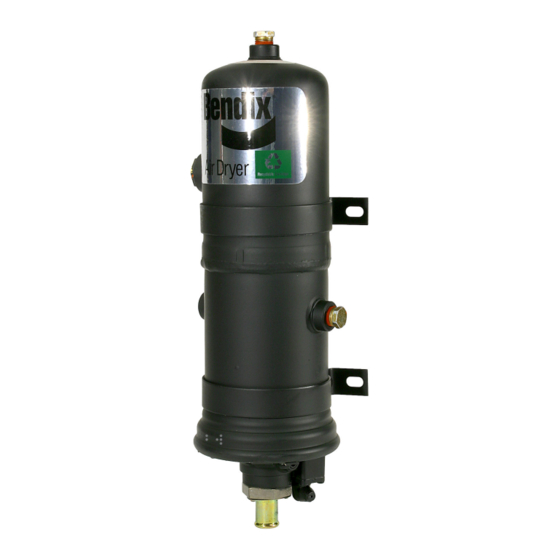BENDIX AD-2 서비스 데이터 - 페이지 15
{카테고리_이름} BENDIX AD-2에 대한 서비스 데이터을 온라인으로 검색하거나 PDF를 다운로드하세요. BENDIX AD-2 16 페이지.
BENDIX AD-2에 대해서도 마찬가지입니다: 매뉴얼 (16 페이지)

SYMPTOM
1. Dryer is constantly
"cycling" or purging.
2. Water in vehicle
reservoirs.
3. Safety valve on the
air dryer "popping off"
or exhausting air.
®
®
BENDIX
AD-2
AIR DRYER TROUBLESHOOTING
CAUSE
A. Excessive system leakage.
B. Excessive leakage in fi ttings, hoses and
tubing connected to compressor, air
dryer and fi rst reservoir.
C. Defective check valve between the air
dryer and fi rst reservoir. (In standard
AD-2 air dryer, check valve to outlet port.)
D. Defective governor.
E. Leaking purge valve in the air dryer end
cover (control side).
F. Compressor unloader mechanism is
leaking excessively.
A. Desiccant requires replacement.
B. Improper discharge line length or
improper line material.
C. Air system charged from outside air
source (outside air not passing through
the air dryer).
D. Air dryer not purging (see Symptom #5).
E. Purge (air exhaust) time insuffi cient due
to excessive system leakage (see causes
for Symptom #1).
F. Air dryer/vehicle application requires
additional purge volume.
G. Air dryer is not compatible with the
vehicle air system requirement -
(Improper air dryer/vehicle application).
A. Desiccant cartridge plugged or saturated.
B. Defective check valve between air dryer
outlet port and fi rst reservoir. (in standard
AD-2 air dryer, check valve in outlet port.)
C. Defective fi ttings, hose or tubing between
air dryer and fi rst reservoir.
Contact the Bendix Tech Team at 1-800-247-2725 (option 2)
or [email protected]. Representatives are available to
assist you Monday – Thursday, 8:00 a.m. – 6:00 p.m. ET
and Friday, 8:00 a.m. – 5:00 p.m. ET.
REMEDY
A. Test for excessive leakage and repair. Allowable
leakage:
• Pre-121 vehicles, single vehicle - 2 psi/minute.
• Tractor trailer - 3 psi/minute.
• 121 vehicles, single vehicle - 1 psi/minute per
service reservoir.
B. Using a soap solution, test for leakage at the fi ttings,
drain valve (if any) and safety valve in the fi rst
reservoir. Repair or replace as necessary.
C. Test the check valve. Leakage should not exceed a
1" soap bubble in 5 seconds. It may be necessary to
remove the air dryer check valve to test. Repair or
replace as necessary.
D. Test the governor for proper cut-in or cut-out
pressures and excessive leakage in both positions.
E. Remove the end cover. Apply 120 psi at the control
port. Soap both sides around purge valve to test for
control piston leakage. (Permissible leakage - 1"
bubble in 5 seconds.)
F. Remove the air strainer or fi tting from the compressor
inlet cavity. With the compressor unloaded, check for
unloader piston leakage. Slight leakage is permissible.
A. Replace the desiccant cartridge.
B. Discharge Line Length:
• Minimum of 6' metal tubing for a two-cylinder
compressor.
• 10' for a one-cylinder compressor.
• fl ex hose can be substituted at ratio of 1-1/2' fl ex
hose for each 1' of metal.
C. If the system must have an outside air fi ll provision,
the outside air should pass through the air dryer.
(Unused inlet on air dryer can be used.) Use of this
should be minimized.
D. See cause and remedy for Symptom #5.
E. Check causes and remedies for Symptom #1.
F. When compressor is loaded (compressing) longer
than 90 seconds during normal operation, additional
purge volume may be needed. (Before proceeding,
contact the Bendix Tech Team. See contact
information below.)
G. Air dryer requires minimum purge time of 30 seconds.
If the compressor stays loaded longer than 90
seconds and ad ditional purge volume is added,
longer purge time is re quired. Air dryer effi ciency
will decrease as compressor loaded time increases
beyond 120 seconds, during normal operation of
the vehicle. (This limitation assumes a com pressor
of approximately 12 CFM and engine operation at
1600-1900 RPM.) The air dryer will accommodate
occa sional longer loaded times, such as the initial
system build-up.
A. Check compressor for excessive oil passing and/or
correct compressor installation. Repair or replace as
necessary. Rebuild or replace the cartridge.
B. Test to determine if air is passing through check valve.
Repair or replace.
C. Check to determine if the air is reaching the fi rst
reservoir. Inspect for kinked tubing or hose. Check for
undrilled or restricted hose or tubing fi ttings.
15
